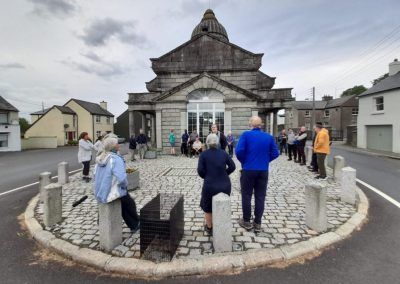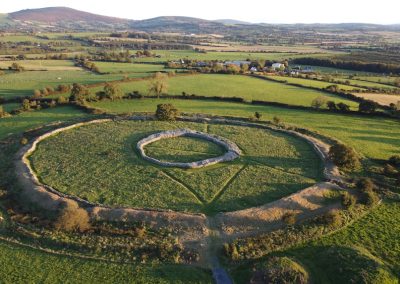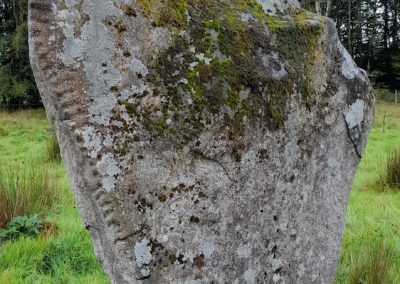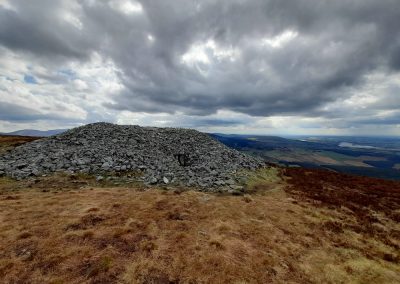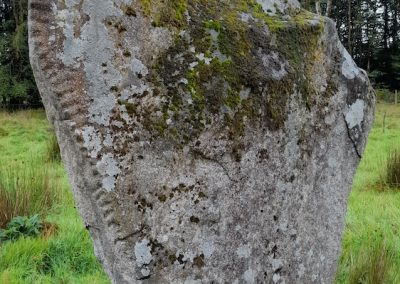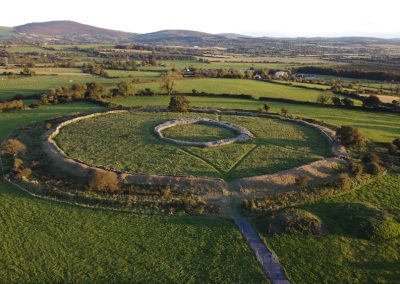About West Wicklow
A brief Introduction to West Wicklow’s Archaeology and History
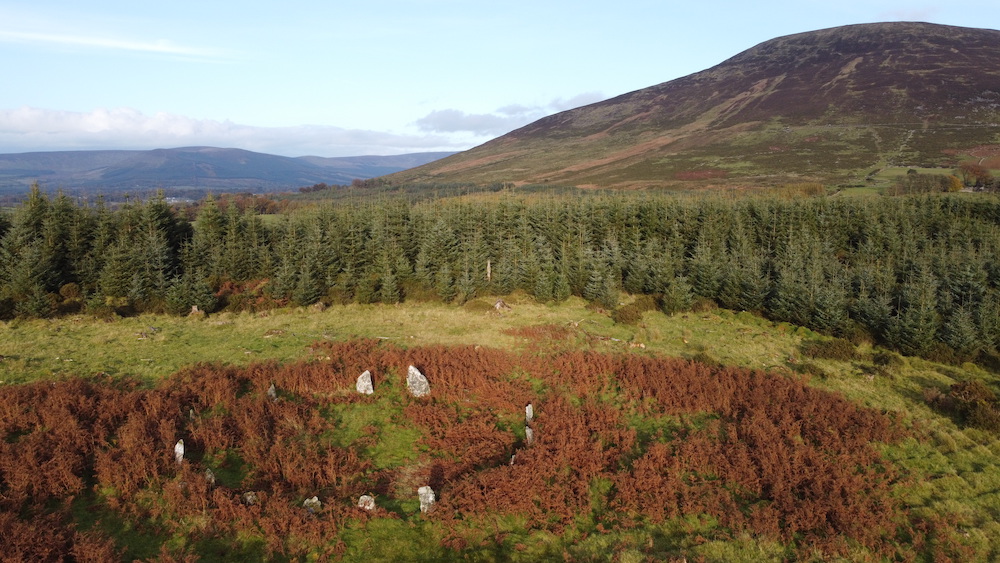
Boleycarrigeen Stone Circle
The area the West Wicklow Historical Society (WWHS) serves roughly aligns with the areas lying west of the Wicklow mountains. The districts encompassed within this area contain a rich and varied history spanning from the prehistoric to the very recent.
From prehistoric times, the WWHS area (between the Wicklow mountains and the Slaney banks) encompassed a strategic pass (and possibly a prized trading route) between the northern and midland districts of the country to the southern coastline. Therefore, it should come as no surprise that the district contains a rich archaeological landscape with several monuments from our Neolithic past, including the hillfort complex around Baltinglass, and various impressive tombs e.g., Seefin passage tomb. The area also contains several impressive examples of stone circles generally associated with late Neolithic/early Bronze Age (with fine examples at Athgreany, Castleruddery and Boleycarrigeen). The impressive Brusselstown Ring Hillfort is also to be found in the area; potentially the ‘Dun Bolg’ mentioned in the annals. The district also contains evidence of the Early Medieval alphabet, known as Ogham writing to be seen at Knickeen and Kilranelagh. The arrival of Christianity has also left its mark in the area; for instance, the Cistercian abbey at the ‘Valley of Salvation’, Baltinglass. Other remnants of this early Christian period include the impressive High Cross of St. Mark, now located in Blessington cemetery.
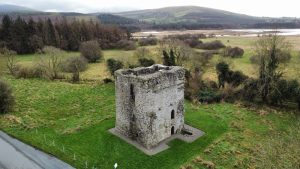
Threecastles at Blessington
The late twelfth century witnessed the arrival of the Normans, and this event also had a direct impact on West Wicklow; large portions of which fell into Norman hands, with neighbouring Gaelic lineages forced to seek refuge in the nearby glens of the Wicklow Mountains. From this point (and several centuries afterwards) the West Wicklow area became a volatile ‘marcher’ land or frontier territory. The Gaelic Resurgence saw the rise of the expelled Gaelic lineages, and a ‘rolling back’ of the Norman colony. Indeed, the growth of Gaelic lineages such as the O’Byrnes and O’Tooles, was part of that Gaelic Resurgence. Both lineages became synonymous with the history of Wicklow during the late medieval and early modern periods. During this time, West Wicklow was very much part of those volatile lands on and adjacent the Pale borders (the castellated structure of Three Castles is a reminder of this volatile frontier), with Norman and Gaelic lineages settled in close proximity to each other. As a result, the area witnessed the almost constant ebb and flow of lordship and land ownership.
Being located near the Pale, frontier during the early modern period, the area witnessed (and often times was directly related to) events such as, the spectacular rise and fall of the Geraldines (the Earls of Kildare); the Baltinglass Rebellion around 1580, the Nine Years War in the late 1590s, alongside the defeat of the Gaelic confederacy at the Battle of Kinsale in 1601 and the subsequent fall of Gaelic Ireland.
Following the decline of Gaelic Ireland and the Uprising of 1641, the area witnessed a large scale transition in land ownership to new English settlers. Out of this transition, sprung settlements such as the beautifully laid out Dunlavin village (among others) in West Wicklow. Later, towards the late 18th century, the district witnessed some bloody events associated with the 1798 Rebellion, in particular the Dunlavin Green Executions. Michael Dwyer, an insurgent leader in the Rebellion is well associated with the district (he was a native of the Glen of Imaal). O’ Dwyer sustained a later guerrilla campaign about the district until his surrender in late 1803.
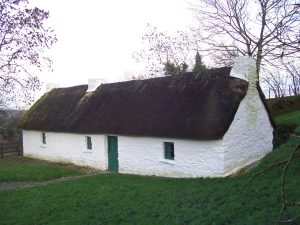
Dwyer-McAllister cottage
Subsequent to the Rebellion came the 1801 Act of Union and the consolidation and development of the estates and ‘big houses’. Indeed, there are many beautiful surviving examples of such residences about the district; for instance, that at Russborough House (among others). During the mid-19th century, the area did not escape the devastation of the Great Famine. Following the Gaelic Revival, the district also witnessed the birth of the Irish State and events during the War of Independence (with incidents recorded at Baltinglass Barracks and Dunlavin in 1920 and 1921 respectively). During the subsequent Civil War, the town and hinterland of Blessington was taken over for a brief period by the Anti-Treaty forces. This force was eventually dislodged. Notwithstanding, the wider district witnessed casualties and deaths related to combat and political violence during the Civil War, including the defeat and capture of an Anti-Treaty flying column near Valleymount, which operated in the hills around West Wicklow.
The foregoing provides a high-level overview of the rich and diverse history of the district. As can be seen, the district has had an interesting and eventful past; tying into various nationally significant events. Indeed, various aspects of the events outlined above are regularly explored, investigated and preserved by WWHS through our numerous journal publications, alongside our regular lectures and tours.
About West Wicklow
An introduction to West Wicklow’s Archaeological Sites
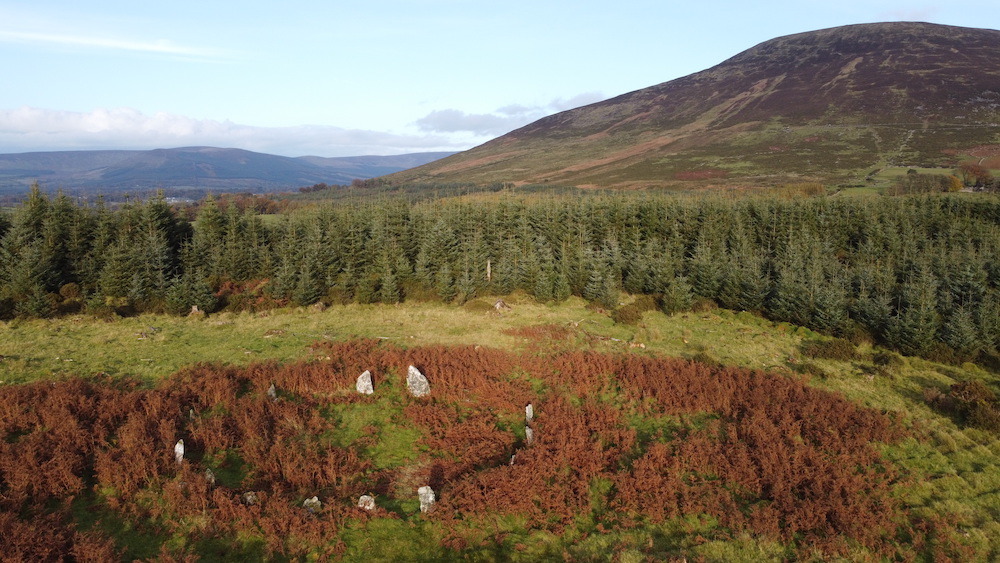
Boleycarrigeen Stone Circle
The area the West Wicklow Historical Society (WWHS) serves roughly aligns with the areas lying west of the Wicklow mountains. The districts encompassed within this area contain a rich and varied history spanning from the prehistoric to the very recent.
From prehistoric times, the WWHS area (between the Wicklow mountains and the Slaney banks) encompassed a strategic pass (and possibly a prized trading route) between the northern and midland districts of the country to the southern coastline. Therefore, it should come as no surprise that the district contains a rich archaeological landscape with several monuments from our Neolithic past, including the hillfort complex around Baltinglass; and various impressive tombs e.g., Seefin passage tomb. The area also contains several impressive examples of stone circles generally associated with late Neolithic/early Bronze Age (with fine examples at Athgreany, Castleruddery and Boleycarrigeen). The impressive Brusselstown Ring Hillfort is also to be found in the area; potentially the ‘Dun Bolg’ mentioned in the annals. The district also contains evidence of the Early Medieval alphabet, known as Ogham writing to be seen at Knickeen and Kilranelagh. The arrival of Christianity has also left its mark in the area; for instance, the Cistercian abbey at the ‘Valley of Salvation’, Baltinglass. Other remnants of this early Christian period include the impressive High Cross of St. Mark, now located in Blessington cemetery.
Read on...

Threecastles at Blessington
The late twelfth century witnessed the arrival of the Normans, and this event also had a direct impact on West Wicklow; large portions of which fell into Norman hands, with neighbouring Gaelic lineages forced to seek refuge in the nearby glens of the Wicklow Mountains. From this point (and several centuries afterwards) the West Wicklow area became a volatile ‘marcher’ land or frontier territory. The Gaelic Resurgence saw the rise of the expelled Gaelic lineages; and a ‘rolling back’ of the Norman colony. Indeed, the growth of Gaelic lineages such as the O’Byrnes and O’Tooles, was part of that Gaelic Resurgence. Both lineages became synonymous with the history of Wicklow during the late medieval and early modern periods. During this time, West Wicklow was very much part of those volatile lands on and adjacent the Pale borders (the castellated structure of Three Castles is a reminder of this volatile frontier); with Norman and Gaelic lineages settled in close proximity to each other. As a result, the area witnessed the almost constant ebb and flow of lordship and land ownership.
Being located near the Pale frontier during the early modern period, the area witnessed (and often times was directly related to) events such as: the spectacular rise and fall of the Geraldines (the Earls of Kildare); the Baltinglass Rebellion around 1580, the Nine Years War in the late 1590s, alongside the defeat of the Gaelic confederacy at the Battle of Kinsale in 1601 and the subsequent fall of Gaelic Ireland.
Following the decline of Gaelic Ireland and the Uprising of 1641, the area witnessed a largescale transition in land ownership to new English settlers. Out of this transition, sprung settlements such as the beautifully laid out Dunlavin village (among others) in West Wicklow. Later, towards the late 18th century, the district witnessed some bloody events associated with the 1798 Rebellion, in particular the Dunlavin Green Executions.Michael Dwyer, an insurgent leader in the Rebellion is well associated with the district (he was a native of the Glen of Imaal); and he sustained a later guerrilla campaign about the district until his surrender in late 1803.

Dwyer-McAllister cottage
Subsequent to the Rebellion came the 1801 Act of Union; and the consolidation and development of the estates and ‘big houses’. Indeed, there are many beautiful surviving examples of such residences about the district; for instance, that at Russborough House (among others). During the mid-19th century, the area did not escape the devastation of the Great Famine. Following the Gaelic Revival, the district also witnessed the birth of the Irish State and events during the War of Independence (with incidents recorded at Baltinglass Barracks and Dunlavin in 1920 and 1921 respectively). During the subsequent Civil War, the town and hinterland of Blessington was taken over for a brief period by the Anti-Treaty forces. This force was eventually dislodged. Notwithstanding, the wider district witnessed casualties and deaths related to combat and political violence during the Civil War, including the defeat and capture of an Anti-Treaty flying column near Valleymount, which operated in the hills around West Wicklow.
The foregoing provides a high-level overview of the rich and diverse history of the district. As can be seen, the district has had an interesting and eventful past; tying into various nationally significant events. Indeed, various aspects of the events outlined above are regularly explored, investigated and preserved by WWHS via our numerous journal publications, alongside our regular lectures and tours.

